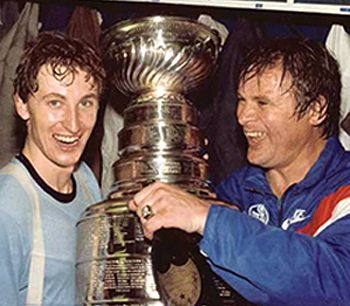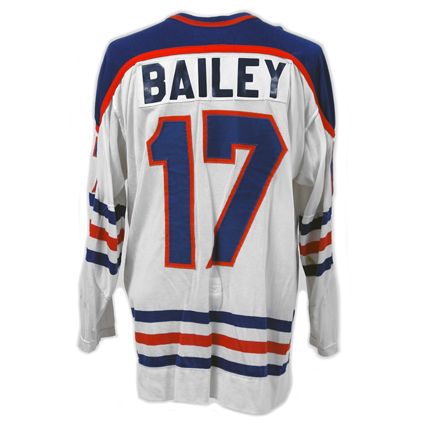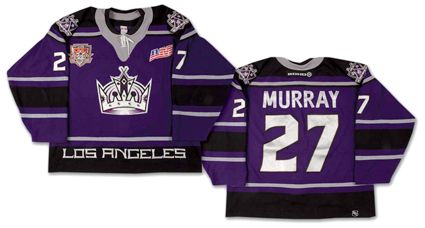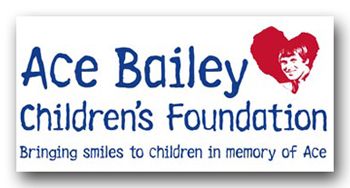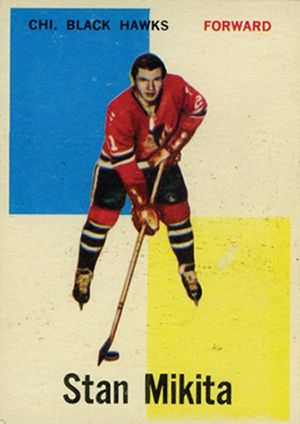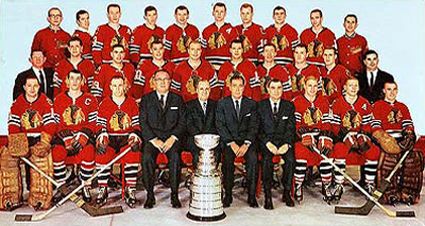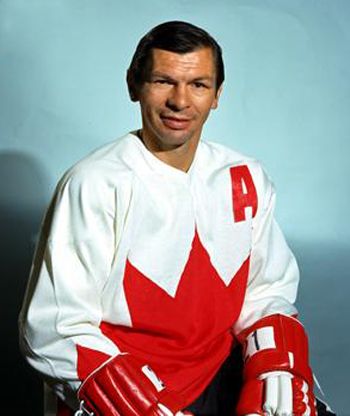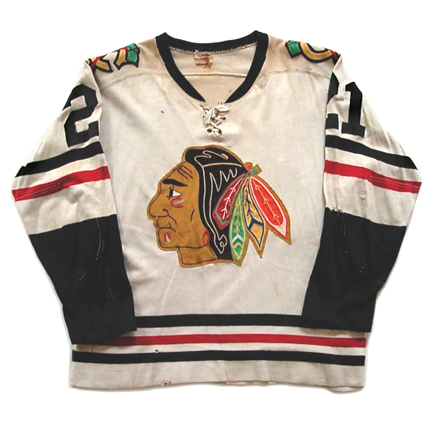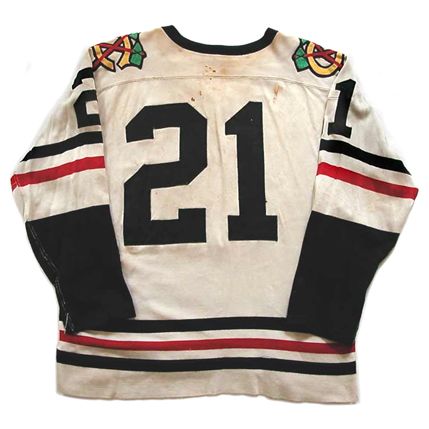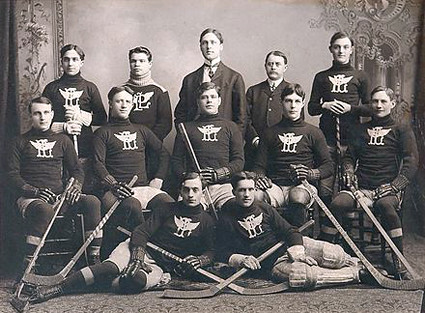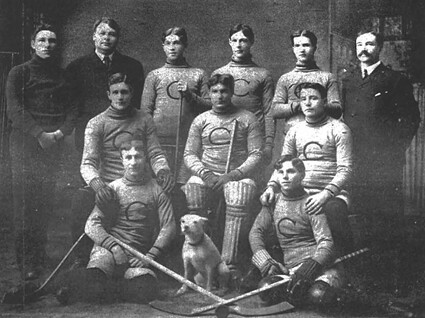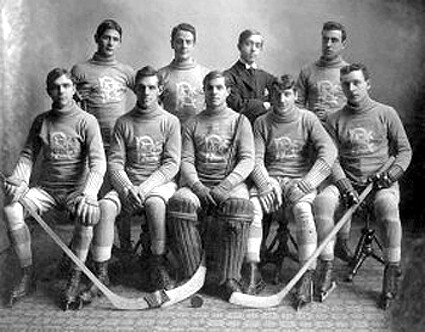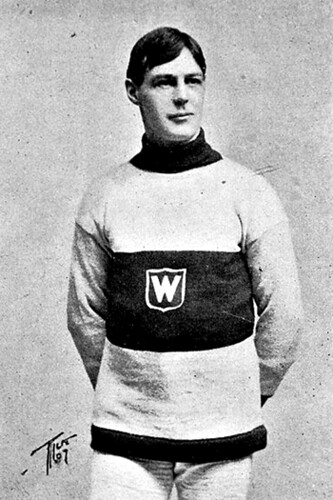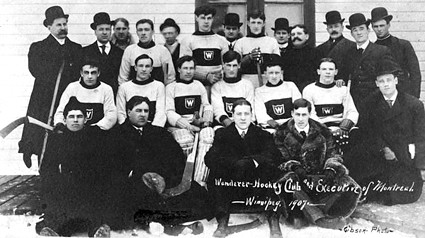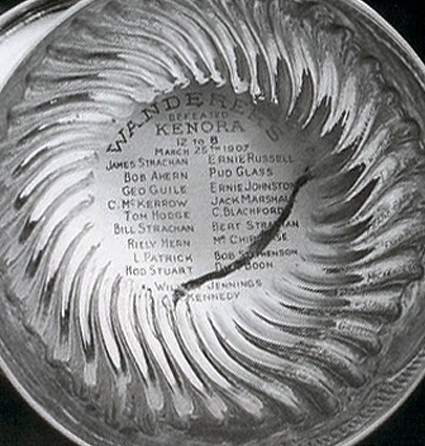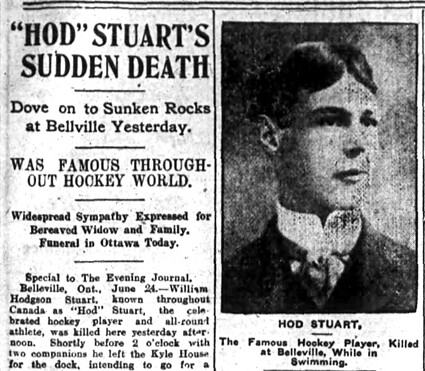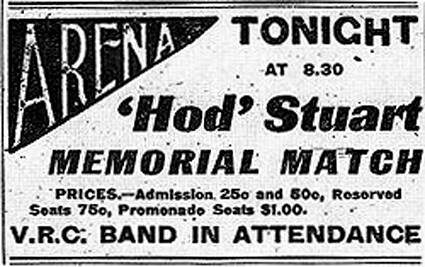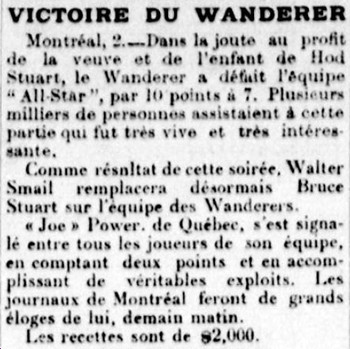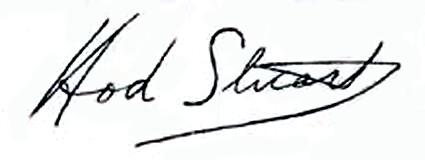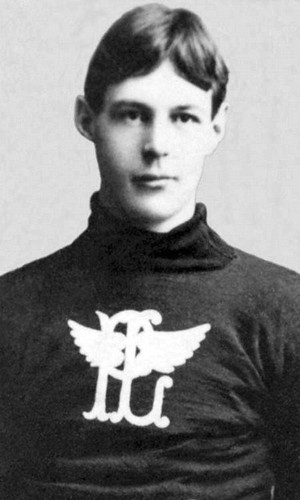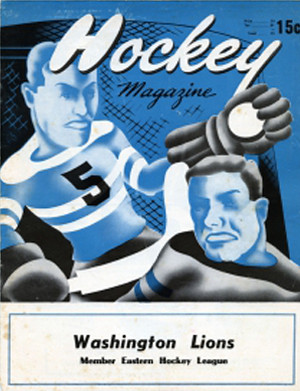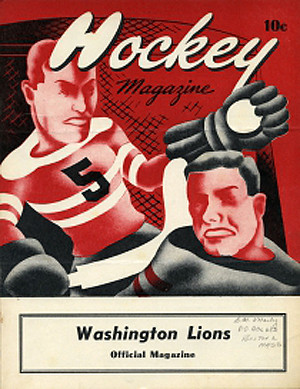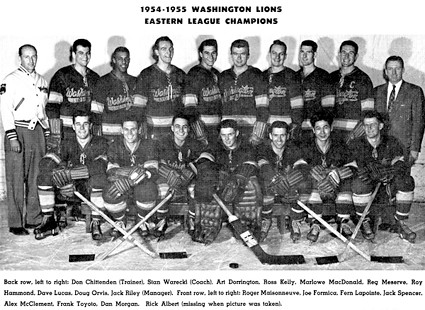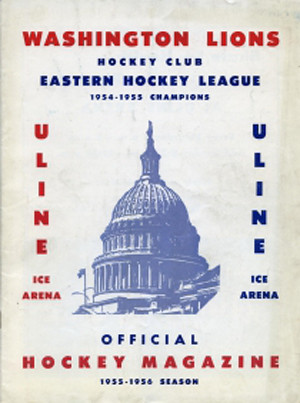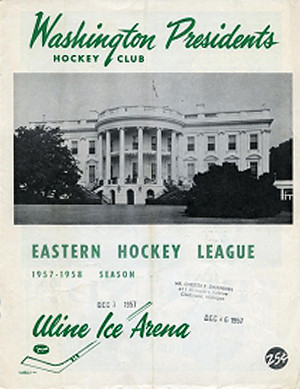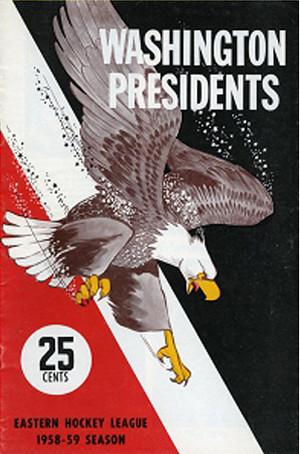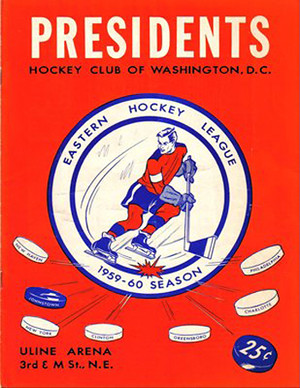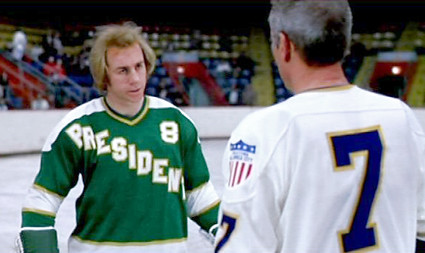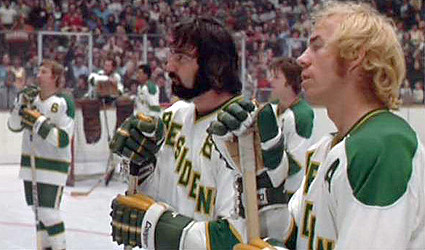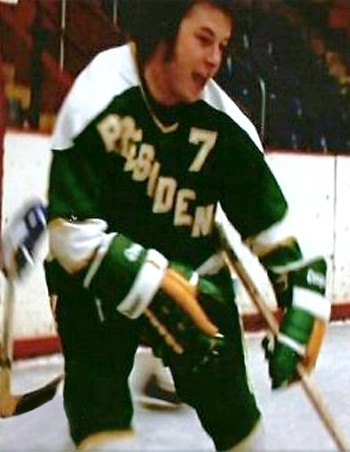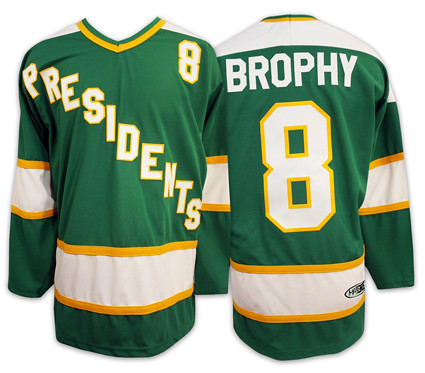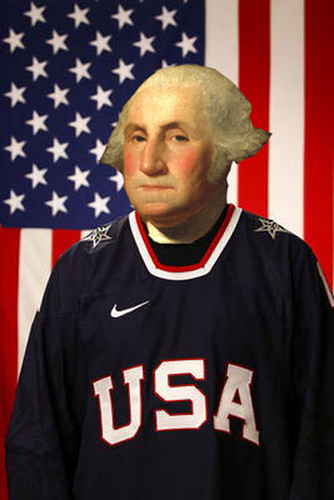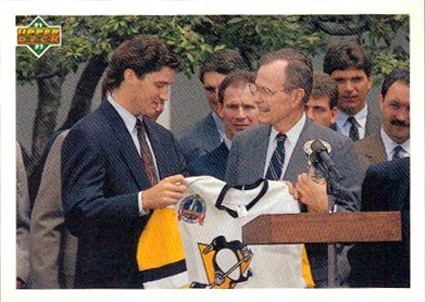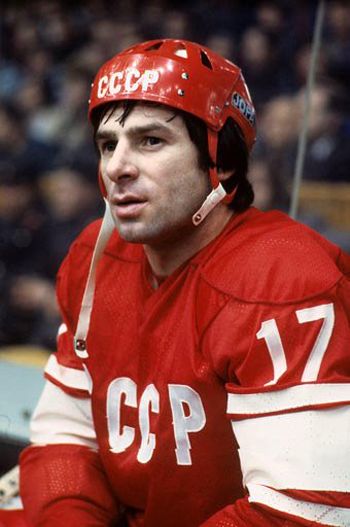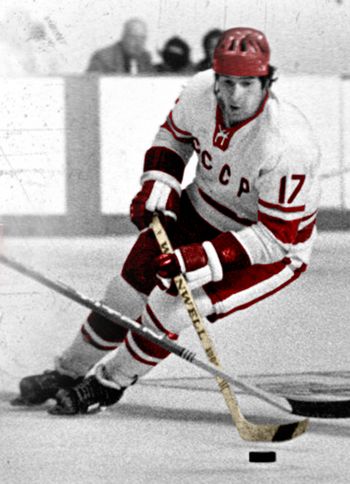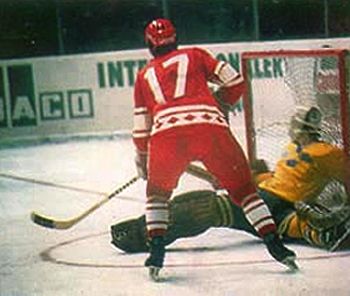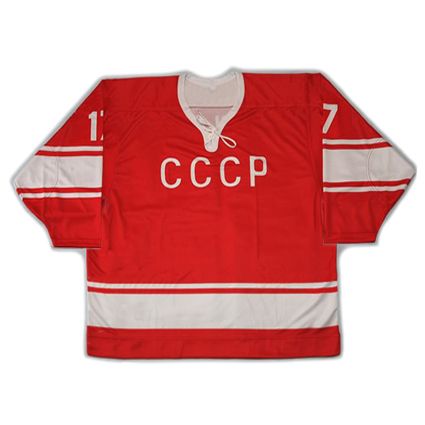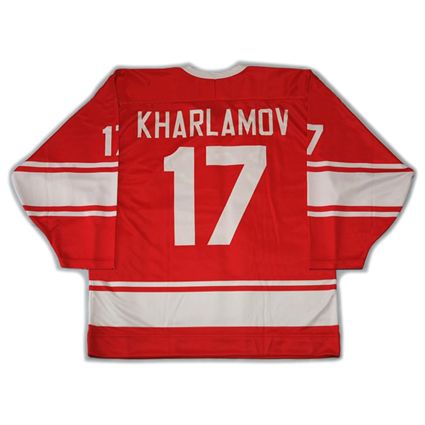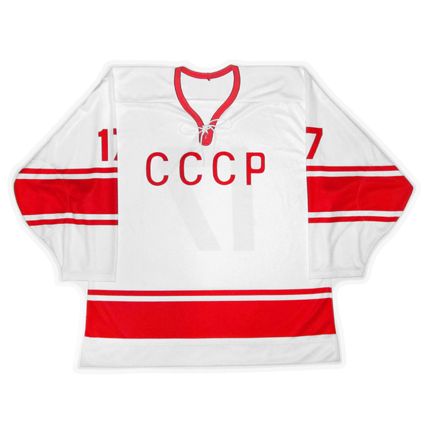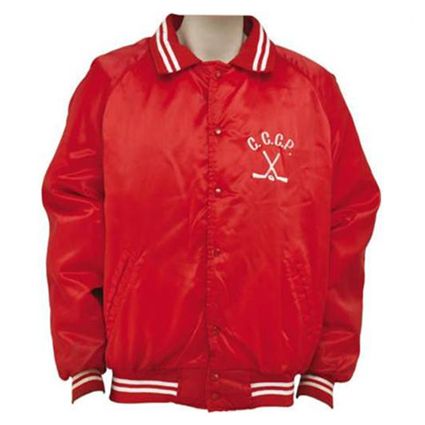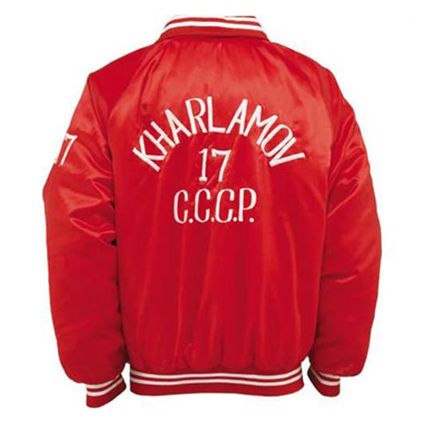Tuesday, September 11, 2018
1978-79 Edmonton Oilers Garnet "Ace" Bailey Jersey
Garnet "Ace" Bailey first played for the Edmonton Oil Kings in junior hockey from 1964 to 1967, including a Memorial Cup championship in 1966.
He was drafted by the Boston Bruins in the 1966 NHL Amateur draft with the 13th overall pick and started his professional career with the Oklahoma City Blazers of the Central Hockey League followed by further seasoning with the Bruins minor league Hershey Bears in the American Hockey League in the 1968-69 season where he had a nice season with 56 points in 60 games. Bailey excelled in the playoffs with 14 points in 9 games as Hersey won the Calder Cup as AHL champions. He also found the time to make his NHL debut with the Bruins, seeing action in eight games during which he scored his first NHL goal on his way to six points. He even got his first taste of NHL playoff action in one postseason game for Boston.
The 1969-70 season saw him crack the Bruins lineup, appearing in 58 regular season games. While Bailey did not suit up for any of the Bruins playoff games, that season (perhaps due to injury) his name was included among those engraved on the Stanley Cup following the Bruins championship, capped off by Bobby Orr's famous cup winning overtime goal in Game 4.
His next season was split between the Boston and Oklahoma City before finally establishing himself as a full-time NHL regular in 1971-72 when he skated in 73 games for the Bruins as well as 13 playoff games, including scoring the game winning goal in Game 1 of the 1972 Stanley Cup Finals versus the New York Rangers, as Bailey got his name on the Stanley Cup for the second time.
Bailey's next three seasons in the NHL were ones of change, as the Bruins traded him to the Red Wings after 57 games of the 1972-73 season. Half way through the next season, Detroit sent Bailey to the St. Louis Blues. Once more Bailey was on the trading block, when St. Louis dealt him to the Washington Capitals after 49 games of the 1974-75 season despite Bailey having already set a career high with 41 points in 49 games for the Blues. Combined with the 17 points he scored in 22 game for the Capitals, his 58 points would remain the best offensive output of his 10 years in the NHL.
Washington proved to be a good fit of Bailey, and he would see action in 67 games in 1975-76 and 78 the following year, his second highest scoring season with 46 points.
Bailey, who was known for his sense of humor once received a four-inch-manual from Capitals head coach Tom McVie, telling him how to get into condition. Bailey used the manual to prop up a beer keg in his bar. On the first day of training camp, according to theSan Francisco Chronicle, Bailey beat several other players in a footrace, and McVie said approvingly, "Ace, I can see you used your book this summer." Bailey replied, "Coach, I used it every day."
Another story relates how McVie once scheduled a practice for the squad at the ungodly hour of 4 AM. As the sleepy players arrived in their hotel lobby, Bailey, impersonating McVie, had already called and cancelled the bus scheduled to take them to the rink, which eventually led to the cancellation of the practice and some much needed additional sleep for the team.
After one more season in Washington, his fourth, Bailey's career would come full circle, as he would return to the scene of his junior hockey roots in Edmonton, this time with the Oilers of the WHA for 38 games where he would become a roommate and mentor a young Wayne Gretzky, becoming one of the few players to play with both Orr and Gretzky.
His playing days concluded with seven games with the CHL's Houston Apollos in 1979-80, before retiring to become their head coach, and a single game with the Wichita Wind of the CHL (while he was their head coach) in 1980-81.
His final NHL totals were 568 games played, 107 goals and 171 assists for 278 points.
Beginning in 1981, he worked as a scout for the Oilers from 1981 to 1994 and win five Stanley Cup rings during the Oilers dynasty from 1984 to 1990, which included his name engraved on the cup three of those times.
Sadly, while working as the director of pro scouting for the Los Angeles Kings, Bailey was a passenger on United Airlines Flight 175 which was crashed into the World Trade Center on September 11, 2001, killing all on board. The Ace Bailey Children's Foundation was established in his memory. To make a donation, simply follow this link.
Today's featured jersey is a 1978-79 Edmonton Oilers "Ace" Bailey jersey as worn during Bailey's only WHA season. The Oilers adopted this style jersey during their third WHA season of 1974-75 and used this version of the logo with the blue lettering on an orange background through their final WHA season of 1978-79. When the Oilers joined the NHL the following season, the logos on both the home and road jerseys were changed to blue letters on a white background, a higher contrast and much more pleasing combination.
Bonus Jersey: Today's bonus jersey is a Koho 2001-02 Los Angeles Kings Glen Murray jersey, which features the "AM" patch in memory of Ace Bailey and Mark Bavis, a fellow scout with the Kings who was also killed on board Flight 175 with Bailey. The jersey also is adorned with the 2002 NHL All-Star Game which was hosted by the Kings that season.
The Kings introduced this purple jersey as an alternate style to their white home and black road jerseys in 1999 and wore it for three seasons. At the time, the all the home jerseys in the NHL were branded as CCM, while the dark and alternate jerseys carried the Koho brand and the practice jerseys were tagged Jofa, as all three brands were part of the same company.
Later, in time for the 2002-03 season, the Kings flipped logos on their jerseys, making the crown logo seen here, the new primary logo for both their white and black jerseys, where it remains in use today, while the purple alternate jersey began to use the coat of arms logo (seen here on the shoulders as a secondary logo) through 2006-07 prior to the purple jersey being discontinued with the change to the new Reebok Edge jerseys, which dictated the temporary elimination of alternate jerseys.
Our first video today is a look at the Ace Bailey Got Skills program, created in Bailey's memory.
Our second video is from the Ace Bailey Children's Foundation.
Again, if you'd like to make a donation, simply click on the image below.
Labels:
9/11,
Bailey Garnet Ace,
Edmonton Oilers
Tuesday, August 7, 2018
1960-61 Chicago Black Hawks Stan Mikita Jersey
Stan Mikita's story is unlike probably any other player in the long history of the NHL. Born Stanislaus Gouth in Sokolce, Czechoslovakia on May 20, 1940, Mikita's family, fearing the political changes in the late 1940's as the Soviet Union's influence over Eastern Europe grew, sent the eight-year-old Stan, who was unfamiliar with hockey, to live with relatives in Canada just as the Iron Curtain closed and he took the family name Mikita of his aunt.
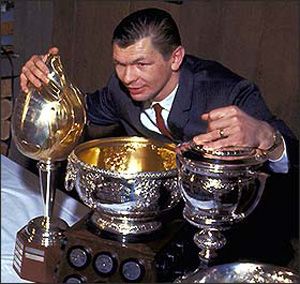
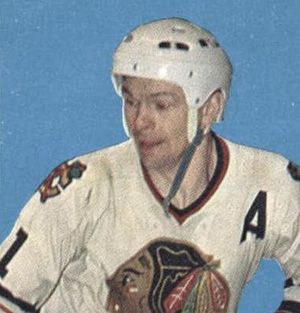
Mikita wearing the Northland Dome helmet
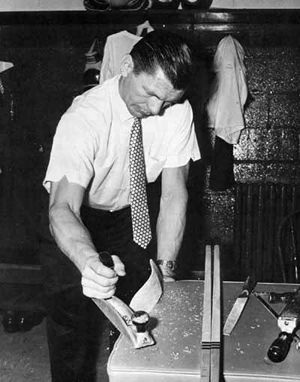
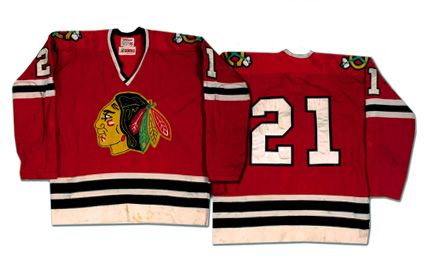
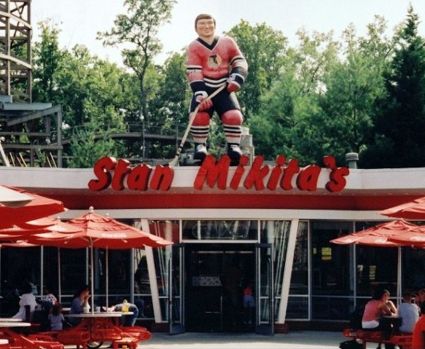
"Hockey was the biggest help in making the adjustment to a new life," Mikita recalled. "I was sitting on the front porch, and eventually I got enough nerve to go down onto the sidewalk to watch. One day they were short a guy, so they motioned for me to come and join them."
"I had no idea how to play hockey, so the first time a guy went around me, I chopped his legs out from under him. I didn't understand a word of English, but one of the older fellows told me, in sign language, "No, we don't play hockey like that." He showed me how to hold the stick and stickhandle. That was my introduction to hockey and where I learned the English language. Needless to say, my vocabulary was limited and included quite a few cusswords."
He made his NHL debut with the Black Hawks in 1958-59 season, becoming the first ever Czechoslovakian-born player in NHL history and scoring his first point and the first of many penalty minutes. He would become a regular the following season, appearing in 67 games, scoring his first NHL goal and racking up 119 penalty minutes, as he employed a rough and feisty style in part due to his smaller size.
"I hadn't completely eliminated the language factor, and kids made fun of me. That made me determined to be better than those kids as a hockey player, but I was also in a lot of scraps. When I got to the NHL in 1959, I was still fighting. My first left-winger was Ted Lindsay, who, at 5 foot 8 inches and 152 pounds, was about my size. I asked Teddy, "You've played 16 years in the league. How did you ever survive?" He answered, "Hit 'em first." I followed that advice and made sure everyone knew that I was tough enough for the NHL," said Mikita.
Mikita would improve his game in 1960-61, more than doubling his goal total to 19 and nearly doubling his assist total to 34 for a 27 point increase in points to 53 in 66 games along with another 100 penalty minutes. Following the regular season, he led all goal scorers with six and helped the Black Hawks win the Stanley Cup for the first time since 1938.
The 1960-61 Stanley Cup champion Chicago Black Hawks
Another leap in production in 1961-62 saw him in the 20's for goals scored with 25 and 52 assists for 77 points, tied for third overall in the league with Gordie Howe, seven behind Chicago teammate Bobby Hull. While the Black Hawks would not repeat as champions, Mikita had 21 points in 12 playoff games as the Black Hawks again made it to the finals.
After another 76 point season, Mikita would capture his first Art Ross Trophy in 1963-64, leading the league in scoring with a career high 89 points on 39 goals and 50 assists, along with 146 penalty minutes, third overall and just 5 behind the league leader.
Mikita would again lead the league in scoring in 1964-65 with 87 points and 154 penalty minutes plus 10 more points in 14 playoff games as they again reached the finals.
Then an amazing thing happened. Mikita returned home from a road trip and his wife told him that their daughter was watching the last road game on TV and asked "Mommy, why does Daddy spend so much time sitting down?" It was at that point that Mikita thought about how to explain to a three-year-old how her father took a penalty he shouldn't have and was being punished for it. He also figured out where his penalty minutes were coming from and made a conscious decision to eliminate "lazy" penalties such as holding, hooking and tripping, as well as his misconduct penalties and began to play a different style of hockey and keep quiet with the referees.
The results were dramatic.
The results were dramatic.
1965-66 saw a drop in penalty minutes to 58, yet he still managed 78 points, second overall.
Mikita's reinvention of his style continued in 1966-67 as he scored 35 goals and 62 assists tying the single season league record of 97 points to capture his third Art Ross Trophy, yet even more surprising was his mere 12 penalty minutes, 142 less than just two seasons prior, which earned him the Lady Byng Award. Had you suggested such a thing was even possible the first six seasons of his career, you would have been laughed at. Mikita is fond of saying, "I realized that you need an awfully long stick to score from the penalty box." The scoring title, along with reinventing his style in play, resulted in Mikita winning the Hart Trophy as well, the first player to ever win all three trophies in a single season.

Mikita poses with his record setting trio of trophies in 1967
He would repeat the triple trophy feat in 1967-68 with a career high 40 goals, 47 assists for 87 points and just 14 penalty minutes and be named the winner of the Lady Byng, Hart and Art Ross trophies his fourth scoring title in five years.
Although his point total increased the following season to 97, tying his career best, he would finish fourth in the scoring race. The next six seasons Mikita's consistent production saw him average 78 points per season, with none lower than 65. During that time period the Black Hawks would make it to the finals in 1970-71 (18 points in 18 games) and 1972-73 (20 points in 15 games).
It was just prior to the 1972-73 season that Mikita would have a homecoming while part of Team Canada. After completing the grueling Summit Series against the Soviet Union, Team Canada travelled to Prague to play the Czechoslovakian National Team. Mikita was named team captain for the contest, which was the first time he was able to play in front of his parents and siblings.
"The welcome I received from the crowd was the proudest moment in my life," said Mikita.
During the 1973-74 season, Mikita played in his 1,000th career game in a 5-3 win over the Minnesota North Stars on December 9, 1973. In doing so, Mikita became only the third player to appear in 1,000 games with Chicago. Additionally, on the same date in 1978, Mikita became only the second player in NHL history to register 900 career assists in a 4-2 win over the St. Louis Blues.
His production would drop from the 80's to the high 50's, partly due to back problems which would eventually cause him to retire in 1980 as the second highest career scoring leader in NHL history, behind only Howe, with 1,467 points from 541 goals and 926 assists in 1,394 games, the 7th most in league history at the time.
His games, assists and points were all Black Hawks records and he would finish his career with 4 Art Ross Trophies, 2 Hart Trophies and 2 Lady Byng Trophies. In addition to his trophy collection, Mikita would appear in nine NHL All-Star Games - 1964, 1967-1969 and 1971 through 1975.
His production would drop from the 80's to the high 50's, partly due to back problems which would eventually cause him to retire in 1980 as the second highest career scoring leader in NHL history, behind only Howe, with 1,467 points from 541 goals and 926 assists in 1,394 games, the 7th most in league history at the time.
His games, assists and points were all Black Hawks records and he would finish his career with 4 Art Ross Trophies, 2 Hart Trophies and 2 Lady Byng Trophies. In addition to his trophy collection, Mikita would appear in nine NHL All-Star Games - 1964, 1967-1969 and 1971 through 1975.
Mikita played on a line with Howe and Hull in the 1967 All-Star Game
He was inducted into the Hockey Hall of Fame in 1983 and the Slovak Hall of Fame in 2002.
In addition to all his scoring exploits, Mikita was also an innovator of hockey equipment, both intentional in unintentional. Following a concussion in 1972-73, Mikita began wearing a helmet designed especially for him with it's distinctive round crown and even put it into production for others to purchase.

Mikita wearing the Northland Dome helmet
Having even more of an impact on how the game is played, Mikita is credited with the innovation of the curved stick blade in the early 1960's.
"My invention of the curved stick came by accident. One day, I cracked my stick in practice, forming an angle in the blade. I was tired and angry at the thought of climbing the 21 stairs to the dressing room to get another stick. I fired a puck in frustration, and the way it left my stick and the sound it made against the boards caught my attention. Before the stick finally broke, I had taken a half a dozen shots, and each time, it was the same."
"After that, I intentionally bent my stick. I broke a lot before I figured out how to make the wood pliable with heat and soaking. I experimented in practice for a month or two before I used a curved blade in a game."

Handyman Mikita ushering in the curved stick era
The curve gave the puck a fluttering path like a baseball knuckleball, moving unexpectedly. Once put into use by Mikita and teammate Bobby Hull, and combined with Hull's notoriously hard slapshot, the curved stick blade quickly became adapted league wide and by 1963 rules were put in place to limit the amount of the curvature to lessen the effect.
Apparently not everyone agrees with this rule...
Today's featured jersey is a 1960-61 Chicago Black Hawks Stan Mikita jersey from the early days of his career. This sweater has the trappings of a 1950's style with the lace-up collar, one color numbers and no name on the back. This was the first variation where the secondary logo of the C with the crossed tomahawks were above the sleeve numbers rather than overlapping the arm stripes and below the sleeve numbers.
This indian head logo sweater, so revered today and often topping Best Jersey Lists, came into being in the 1955-56 season, replacing the previous style which had a small indian head of a different design contained in a circle logo. The 1955-56 version had no sleeve numbers and a slightly different main crest design before the logo changed to today's more familiar version and sleeve numbers were added in 1957-58. Note today's jersey has two sleeve stripes and long black cuffs, which were changed to three stripes to match the waist striping for the 1963-64 season.
Bonus jersey: Today's bonus jersey is a 1973-74 Chicago Black Hawks Stan Mikita jersey from the season in which he played his 1,000th game. This was the first season that the Black Hawks numbers were two colors, previously being one color white numbers. The Black Hawks would not being using names on the back of their jerseys until 1977.
This indian head logo sweater, so revered today and often topping Best Jersey Lists, came into being in the 1955-56 season, replacing the previous style which had a small indian head of a different design contained in a circle logo. The 1955-56 version had no sleeve numbers and a slightly different main crest design before the logo changed to today's more familiar version and sleeve numbers were added in 1957-58. Note today's jersey has two sleeve stripes and long black cuffs, which were changed to three stripes to match the waist striping for the 1963-64 season.
Bonus jersey: Today's bonus jersey is a 1973-74 Chicago Black Hawks Stan Mikita jersey from the season in which he played his 1,000th game. This was the first season that the Black Hawks numbers were two colors, previously being one color white numbers. The Black Hawks would not being using names on the back of their jerseys until 1977.

We hope you have some time on your hands today, as we mine a rich vein of video about Stan Mikita and his lengthy career.
First up, highlights of the 1961 Stanley Cup Finals Game 6 where Mikita assisted on the game winning goal, the first Stanley Cup won by the Black Hawks in 38 years and the only one of Mikita's career.
Here is an interview with Mikita who discusses the creation of the helmet he wore and the incident that led to the development of the curved stick and gives you a glimpse of his self-depreciating sense of humor.
Next is a nice career retrospective on Mikita.
In one of the nicer stories in hockey of the last few seasons, here is Mikita talking about rejoining the Chicago Blackhawks family as an ambassador for the team followed by the long overdue Bobby Hull and Stan Mikita Night.
For further viewing, this two part profile of Mikita from 1995 is also recommended. Part One. Part Two.
Finally, for fan's of the movie Wayne's World, no one should be without their own Stan Mikita's Donuts t-shirt.

Labels:
Chicago Blackhawks,
Mikita Stan
Tuesday, February 20, 2018
1903-04 Portage Lakes Hod Stuart Jersey
William Hodgson "Hod" Stuart was born on this date in Ottawa, Ontario in 1879. His first senior level team was the Rat Portage Thistles in 1895-96. He joined the Ottawa Hockey Club (later known as the Silver Seven and then the Senators) of the Canadian Amateur Hockey League for the 1898-99 season for three games. A cover-point (later known as the more familiar term of a defenseman), Stuart played in 3 games, scoring one goal for Ottawa while his brother Bruce Stuart played in one game for the team.
Stuart returned to Ottawa HC for the 1899-00 season and was named the team captain. He played in seven of the team's eight games, scoring 5 goals, as he was not afraid to join the offense from his defensive role.
As hockey was still a purely amateur sport in those days, Stuart moved to Quebec when he was able to land a job there though his father's business contacts. The change in location led to him joining the Quebec Bulldogs, also of the CAHL, for the 1900-01 season and his brother Bruce did the same. Again, he played in seven of the club's eight games, scoring twice.
He returned for a second season with the Bulldogs in 1901-02, scoring 5 times in 8 games.
As professionalism started to come into the game, Stuart was signed for the princely sum of $15-$20 per week for the 1902-03 season by the Pittsburgh Bankers of the Western Pennsylvania Hockey League in the United States, in addition to his income from his day job in Pittsburgh. In 13 games, Stuart scored 7 goals and 8 assists with 29 penalty minutes as the Bankers finished first in the four team league with a 10-3-1 record. Stuart was named the best cover-point in the league.
After one season in Pittsburgh, Stuart moved further west with his brother Bruce to join the professional Portage Lakes Hockey Club in Northern Michigan for the 1903-04 season. The club was not part of any league that season and played a schedule of 14 exhibition games, with Stuart scoring 13 goals while Bruce had an astonishing 44!
For the 1905-06 season, the American Soo Indians and Canadian Sault were banned from competing in the amateur Ontario Hockey Association after having played against the professionals from Portage Lakes. The solution was the formation of a new, professional league, which consisted of five teams, which was dubbed the International Hockey League.
Stuart was given $1,800 to play for the Calumet Miners as well as manage their rink for the season. While Hod changed teams, Bruce remained with Portage Lakes for the next three seasons.
Stuart scored 18 goals in 22 games for the Miners, who won the league championship with a 18-5-1 record, as he was named the best cover-point in the league.
On December 11, 1905, Stuart was suspended from the league after other teams complained he had won too many championships and was too rough a player. He was reinstated on December 30th and joined the Pittsburgh Professionals for the remainder of their season, scoring 11 times in 20 games. After Pittsburgh completed their schedule, Stuart suited up for one additional game for Calumet.
Stuart began the 1906-07 season with Pittsburgh in the IPHL, but after 4 games with a goal and 3 assists, he grew increasingly frustrated with the violence and refereeing in the league and went so far as to have a letter critical of the league and its officiating. Shortly afterwards, the Pittsburgh players refused to play a game against the Michigan Soo due to the choice of referee. The club's management felt that Stuart was the instigator of the boycott and released him from the club.
Having heard earlier that the Montreal Wanderers of the Eastern Canada Amateur Hockey Association were not only interested in his services, but willing to make hm the highest paid player in hockey, signed with the Wanderers and made his debut on January 2, 1907 in front of 6,069 fans. He would eventually play in 8 of the Wanderers 10 regular season games, scoring 3 times and was one of only four professionals to play for the club that season. With Montreal, he was once again reunited with Bruce, who also played 3 regular season and 3 Stanley Cup games with the Wanderers that season.
If Stuart was unhappy with the level of violence in the IPHL, he certainly was not pleased with the events of January 12th, when the Ottawa Senators repeatedly battered the Wanderers players with their sticks, with Charles Spittal's attack on Cecil Blanchford later being described at "attempting to split his skull", while the Senators Alf Smith hit Stuart "across the temple, laying him out like a corpse", while Harry Smith broke Ernie Johnson's face, breaking his nose. Reports of the game commended Stuart, stating that he neither flinched or retaliated, even after bearing most of the hits.
At a special league meeting, the Montreal Victorias proposed suspending Spittal and Alf Smith for the rest of the season, which was voted down and eventually led to the league president Fred McRobie resigning. When the Senators returned to Montreal, Spittal, Alf Smith and Harry Smith were all arrested, with Spittal and Alf Smith eventually paying $20 fines.
On January 17th and 21st, the Wanderers faced a challenge for the Stanley Cup they had won the previous March. Kenora, the 1906 Manitoba champions, pulled off an upset, wresting the cup away from the Wanderers by winning 4-2 and 8-6.
Afterwards, the Wanderers focused on their ECAHA schedule, and racked up win after win, eventually finishing the season as league champions after a perfect 10-0 undefeated season with Stuart contributing 3 goals in eight games.
That championship earned them the right to a rematch with Kenora, which took place on March 23rd and 25th in Winnipeg. Montreal dominated the first game 7-2, and even though the Thistles won Game 2 by a score of 6-5, the Wanderers large margin of victory in the first game gave them ta 12-8 win in the two game, total goals series, giving Stuart a Stanley Cup championship.
In celebration of their championship, the Wanderers engraved the names of their entire roster inside the bowl of the Stanley Cup, the first winning team to do so in what is now and annual tradition.
Tired of the violence in hockey, Stuart quit playing hockey after the Stanley Cup matches and joined his father in the construction business. As part of his duties, he was sent to Belleville, Ontario to oversee a construction project. On the afternoon of June 23, 1907, he went swimming with some friends and swam to a nearby lighthouse, climbed on a platform and dove onto some obscured rocks in the shallow water and died instantly of a broken neck at the age of 28 just three months after he and the Wanderers won the Stanley Cup in 1907.
On January 2, 1908 (nine years before the creation of the National Hockey League) an all-star benefit game was held as a benefit for the family of Stuart with the tickets sold out days in advance.
In that first all-star game ever held in any sport, the Montreal Wanderers faced off against a team of players from the Eastern Canada Amateur Hockey Association with the game hosted at no charge by the Westmount Arena in front of 3,800 fans, raising over $2,100 for his widow and two children.
The Wanderers led 7-1 after the first half of the contest, but the All-Stars, which consisted of players from the Ottawa Senators, Montreal Victorias, Montreal Amateur Athletic Association, Montreal Shamrocks and Quebec Bulldogs, fought back to make it a game, but the Wanderers prevailed by a final score of 10-7.
Stuart was inducted into the Hockey Hall of Fame in 1945, one of the original nine honored members of the inaugural class along with Hobey Baker, Charlie Gardiner, Eddie Gerard, Frank McGee, Howie Morenz, Tommy Phillips, Harvey Pulford and Georges Vezina.
Today's featured jersey is a 1903-04 Portage Lakes Hockey Club Hod Stuart jersey. The Portage Lakes Hockey Club was founded back in 1899 and began to pay its players in 1902. They introduced their winged logo for the 1902-03 season with sweaters that had white shoulders and turtleneck collar. For the following season they sweaters became a solid color and remained so through their final season of 1906-07 when the IPHL folded and the Portage Lakes club along with it. We have seen a single mention that the team's sweaters were green, but cannot be certain of this.
Noteworthy players enticed by the lure of being paid to play hockey who suited up for Portage Lakes at times included Hall of Famers "Bad" Joe Hall, Riley Hern, Bruce Stuart, Hod Stuart and Fred "Cyclone" Taylor.
Stuart returned to Ottawa HC for the 1899-00 season and was named the team captain. He played in seven of the team's eight games, scoring 5 goals, as he was not afraid to join the offense from his defensive role.
As hockey was still a purely amateur sport in those days, Stuart moved to Quebec when he was able to land a job there though his father's business contacts. The change in location led to him joining the Quebec Bulldogs, also of the CAHL, for the 1900-01 season and his brother Bruce did the same. Again, he played in seven of the club's eight games, scoring twice.
He returned for a second season with the Bulldogs in 1901-02, scoring 5 times in 8 games.
As professionalism started to come into the game, Stuart was signed for the princely sum of $15-$20 per week for the 1902-03 season by the Pittsburgh Bankers of the Western Pennsylvania Hockey League in the United States, in addition to his income from his day job in Pittsburgh. In 13 games, Stuart scored 7 goals and 8 assists with 29 penalty minutes as the Bankers finished first in the four team league with a 10-3-1 record. Stuart was named the best cover-point in the league.
After one season in Pittsburgh, Stuart moved further west with his brother Bruce to join the professional Portage Lakes Hockey Club in Northern Michigan for the 1903-04 season. The club was not part of any league that season and played a schedule of 14 exhibition games, with Stuart scoring 13 goals while Bruce had an astonishing 44!
The 1903-04 Portage Lakes Hockey Club
For the 1905-06 season, the American Soo Indians and Canadian Sault were banned from competing in the amateur Ontario Hockey Association after having played against the professionals from Portage Lakes. The solution was the formation of a new, professional league, which consisted of five teams, which was dubbed the International Hockey League.
Stuart was given $1,800 to play for the Calumet Miners as well as manage their rink for the season. While Hod changed teams, Bruce remained with Portage Lakes for the next three seasons.
Stuart scored 18 goals in 22 games for the Miners, who won the league championship with a 18-5-1 record, as he was named the best cover-point in the league.
The 1904-05 Calumet Miners Hockey Club
On December 11, 1905, Stuart was suspended from the league after other teams complained he had won too many championships and was too rough a player. He was reinstated on December 30th and joined the Pittsburgh Professionals for the remainder of their season, scoring 11 times in 20 games. After Pittsburgh completed their schedule, Stuart suited up for one additional game for Calumet.
The 1905-06 Pittsburgh Professionals
Stuart began the 1906-07 season with Pittsburgh in the IPHL, but after 4 games with a goal and 3 assists, he grew increasingly frustrated with the violence and refereeing in the league and went so far as to have a letter critical of the league and its officiating. Shortly afterwards, the Pittsburgh players refused to play a game against the Michigan Soo due to the choice of referee. The club's management felt that Stuart was the instigator of the boycott and released him from the club.
Having heard earlier that the Montreal Wanderers of the Eastern Canada Amateur Hockey Association were not only interested in his services, but willing to make hm the highest paid player in hockey, signed with the Wanderers and made his debut on January 2, 1907 in front of 6,069 fans. He would eventually play in 8 of the Wanderers 10 regular season games, scoring 3 times and was one of only four professionals to play for the club that season. With Montreal, he was once again reunited with Bruce, who also played 3 regular season and 3 Stanley Cup games with the Wanderers that season.
Stuart joined the Montreal Wanderers after his release from Pittsburgh
If Stuart was unhappy with the level of violence in the IPHL, he certainly was not pleased with the events of January 12th, when the Ottawa Senators repeatedly battered the Wanderers players with their sticks, with Charles Spittal's attack on Cecil Blanchford later being described at "attempting to split his skull", while the Senators Alf Smith hit Stuart "across the temple, laying him out like a corpse", while Harry Smith broke Ernie Johnson's face, breaking his nose. Reports of the game commended Stuart, stating that he neither flinched or retaliated, even after bearing most of the hits.
At a special league meeting, the Montreal Victorias proposed suspending Spittal and Alf Smith for the rest of the season, which was voted down and eventually led to the league president Fred McRobie resigning. When the Senators returned to Montreal, Spittal, Alf Smith and Harry Smith were all arrested, with Spittal and Alf Smith eventually paying $20 fines.
On January 17th and 21st, the Wanderers faced a challenge for the Stanley Cup they had won the previous March. Kenora, the 1906 Manitoba champions, pulled off an upset, wresting the cup away from the Wanderers by winning 4-2 and 8-6.
Afterwards, the Wanderers focused on their ECAHA schedule, and racked up win after win, eventually finishing the season as league champions after a perfect 10-0 undefeated season with Stuart contributing 3 goals in eight games.
That championship earned them the right to a rematch with Kenora, which took place on March 23rd and 25th in Winnipeg. Montreal dominated the first game 7-2, and even though the Thistles won Game 2 by a score of 6-5, the Wanderers large margin of victory in the first game gave them ta 12-8 win in the two game, total goals series, giving Stuart a Stanley Cup championship.
The 1906-07 Stanley Cup champion Montreal Wanderers
In celebration of their championship, the Wanderers engraved the names of their entire roster inside the bowl of the Stanley Cup, the first winning team to do so in what is now and annual tradition.
engraved their entire roster into the Stanley Cup
Tired of the violence in hockey, Stuart quit playing hockey after the Stanley Cup matches and joined his father in the construction business. As part of his duties, he was sent to Belleville, Ontario to oversee a construction project. On the afternoon of June 23, 1907, he went swimming with some friends and swam to a nearby lighthouse, climbed on a platform and dove onto some obscured rocks in the shallow water and died instantly of a broken neck at the age of 28 just three months after he and the Wanderers won the Stanley Cup in 1907.
A newspaper account of Stuart's accident
On January 2, 1908 (nine years before the creation of the National Hockey League) an all-star benefit game was held as a benefit for the family of Stuart with the tickets sold out days in advance.
An ad for the first All-Star Game,
a fundraiser for the family of Hod Stuart
In that first all-star game ever held in any sport, the Montreal Wanderers faced off against a team of players from the Eastern Canada Amateur Hockey Association with the game hosted at no charge by the Westmount Arena in front of 3,800 fans, raising over $2,100 for his widow and two children.
The Wanderers led 7-1 after the first half of the contest, but the All-Stars, which consisted of players from the Ottawa Senators, Montreal Victorias, Montreal Amateur Athletic Association, Montreal Shamrocks and Quebec Bulldogs, fought back to make it a game, but the Wanderers prevailed by a final score of 10-7.
A newspaper account of the Hod Stuart Memorial Game
Stuart was inducted into the Hockey Hall of Fame in 1945, one of the original nine honored members of the inaugural class along with Hobey Baker, Charlie Gardiner, Eddie Gerard, Frank McGee, Howie Morenz, Tommy Phillips, Harvey Pulford and Georges Vezina.
Today's featured jersey is a 1903-04 Portage Lakes Hockey Club Hod Stuart jersey. The Portage Lakes Hockey Club was founded back in 1899 and began to pay its players in 1902. They introduced their winged logo for the 1902-03 season with sweaters that had white shoulders and turtleneck collar. For the following season they sweaters became a solid color and remained so through their final season of 1906-07 when the IPHL folded and the Portage Lakes club along with it. We have seen a single mention that the team's sweaters were green, but cannot be certain of this.
Noteworthy players enticed by the lure of being paid to play hockey who suited up for Portage Lakes at times included Hall of Famers "Bad" Joe Hall, Riley Hern, Bruce Stuart, Hod Stuart and Fred "Cyclone" Taylor.
Monday, February 19, 2018
President's Day - 1976-77 Hyannisport Presidents Nick Brophy Jersey
With today being President's Day in the United States, we felt it was an appropriate time to take a look at hockey teams named Presidents.
The first such team actually began life as the Washington Lions of the Eastern Hockey League in the 1951-52 season, replacing a previous American Hockey League team of the same name who left Washington DC after the 1948-49 season. The EHL Lions had a extremely tough time their first season, withdrawing from the league due to poor attendance on January 15, 1952 after 36 of a scheduled 68 games with a 9-24-3 record.
The Lions returned to try again in 1952-53 and not only played the entire season, but were able to make the playoffs after finishing fourth out of five with a 26-31-3 record which was followed by a first round playoff exit.
Down to just five teams in 1952-53, the entire EHL did not operate during the 1953-54 season. When the league returned in 1954-55, Washington finished first overall with a 26-21-2 record and then defeated the New Haven Blades 3-1 before sweeping the Baltimore Clippers in four to win the EHL championship.
They finished mid-pack in 1955-56 at 33-28-3 and were led by Fern Lapointe's 92 points but were a first round playoff exit. The Lions plummeted to last place in 1956-57, winning just 18 times out of 64 tries.
For the 1957-58 season, the club changed its name to the Washington Presidents. They were led in scoring by Wally Kullman, the only player on the team to average more than a point per game with 26 goals and 63 points, playing in 60 of the team's 64 games. The club finished second in the regular season with a 38-24-4 record for 76 points, just one back of the Charlotte Clippers. They defeated the Johnstown Jets 4-2 and then outlasted the Clippers in a full seven game final to win the 1958 EHL championship after their first season as the Presidents.
Kullman again led the team in 1958-59, only in much more dominant fashion, with 41 goals and 56 assists for 97 points, far ahead of his next closest teammate with 69. While Kullman's 97 points were good for third in the league, the team finished fifth out of six and out of the playoffs at 29-35.
The 1959-60 Presidents were led by Ken Davies' 65 points and Dan Patrick's 64. The team once again missed the playoffs after finishing last in the Southern Division with 25 wins, 35 losses and 5 ties.
This would prove to be the final season of the Presidents, as the club folded after eight seasons due to financial difficulties. Washington D.C. would be without hockey for 14 seasons until the arrival of the Washington Capitals of the NHL for the 1974-75 season.
The best known team to be called the Presidents would be the Hyannisport Presidents of the fictional Federal League from the 1977 movie Slap Shot starring Paul Newman. The Presidents appear in the movie's first game action, where center Nick Brophy confesses to the Charlestown Chiefs player/coach Reg Dunlop that he is drunk, his wife left him and "if anyone throws me against the boards, I'm going to piss all over myself."
Once the Chiefs players realize Brophy is plastered, the Chiefs leading scorer Ned Braden, checks him into the boards and warns him to "Get off the ice. You're going to kill yourself." Brophy, having been checked, does indeed wet himself and slinks off the ice, hoping no one has noticed his predicament.
Later in the film, with the Chiefs playing much better having added the notorious Hanson Brothers to the roster, travel to Hyannisport. An incensed Presidents fan hurls a set of keys at Jeff Hanson, which prompts the brothers to invade the stands, looking for retaliation as the Presidents look on.
A melee breaks out as the most of the Chiefs follow close behind. In the end, the Hanson's need to be bailed out of the Hyannisport jail before the Chiefs can return home to Charlestown.
Of note, the actual Hyannis Port, Massachusetts is two words, but in the film, the team is referred to as the single word "Hyannisport" on scoreboards and the town's welcome sign in the film.
Perhaps the most famous Presidents' alumni is #7 Bruce Boudreau, who was with the real life Johnstown Jets at the time of the filming of Slap Shot. Cast as one of the Presidents in the movie, he would later go on to play 30 games in the WHA, 141 in the NHL, 30 in Germany, 145 in the CHL, 240 in the IHL and 634 in the AHL scoring 574 goals. He would later go on to become head coach of the Washington Capitals, Anaheim Ducks and currently the Minnesota Wild.
Today's featured jersey is a 1976-77 Hyannisport Presidents Nick Brophy jersey. The Presidents jerseys may look familiar to those with a keen eye for history, as the striping template and coloring for their jerseys is that used by the Minnesota North Stars from 1968-69 through 1974-75.
The first such team actually began life as the Washington Lions of the Eastern Hockey League in the 1951-52 season, replacing a previous American Hockey League team of the same name who left Washington DC after the 1948-49 season. The EHL Lions had a extremely tough time their first season, withdrawing from the league due to poor attendance on January 15, 1952 after 36 of a scheduled 68 games with a 9-24-3 record.
The Lions returned to try again in 1952-53 and not only played the entire season, but were able to make the playoffs after finishing fourth out of five with a 26-31-3 record which was followed by a first round playoff exit.
Down to just five teams in 1952-53, the entire EHL did not operate during the 1953-54 season. When the league returned in 1954-55, Washington finished first overall with a 26-21-2 record and then defeated the New Haven Blades 3-1 before sweeping the Baltimore Clippers in four to win the EHL championship.
They finished mid-pack in 1955-56 at 33-28-3 and were led by Fern Lapointe's 92 points but were a first round playoff exit. The Lions plummeted to last place in 1956-57, winning just 18 times out of 64 tries.
The franchise's final season with the Lions moniker came in 1956-57
For the 1957-58 season, the club changed its name to the Washington Presidents. They were led in scoring by Wally Kullman, the only player on the team to average more than a point per game with 26 goals and 63 points, playing in 60 of the team's 64 games. The club finished second in the regular season with a 38-24-4 record for 76 points, just one back of the Charlotte Clippers. They defeated the Johnstown Jets 4-2 and then outlasted the Clippers in a full seven game final to win the 1958 EHL championship after their first season as the Presidents.
The team was rechristened the Presidents in 1957
Kullman again led the team in 1958-59, only in much more dominant fashion, with 41 goals and 56 assists for 97 points, far ahead of his next closest teammate with 69. While Kullman's 97 points were good for third in the league, the team finished fifth out of six and out of the playoffs at 29-35.
The 1959-60 Presidents were led by Ken Davies' 65 points and Dan Patrick's 64. The team once again missed the playoffs after finishing last in the Southern Division with 25 wins, 35 losses and 5 ties.
This would prove to be the final season of the Presidents, as the club folded after eight seasons due to financial difficulties. Washington D.C. would be without hockey for 14 seasons until the arrival of the Washington Capitals of the NHL for the 1974-75 season.
The best known team to be called the Presidents would be the Hyannisport Presidents of the fictional Federal League from the 1977 movie Slap Shot starring Paul Newman. The Presidents appear in the movie's first game action, where center Nick Brophy confesses to the Charlestown Chiefs player/coach Reg Dunlop that he is drunk, his wife left him and "if anyone throws me against the boards, I'm going to piss all over myself."
Once the Chiefs players realize Brophy is plastered, the Chiefs leading scorer Ned Braden, checks him into the boards and warns him to "Get off the ice. You're going to kill yourself." Brophy, having been checked, does indeed wet himself and slinks off the ice, hoping no one has noticed his predicament.
Later in the film, with the Chiefs playing much better having added the notorious Hanson Brothers to the roster, travel to Hyannisport. An incensed Presidents fan hurls a set of keys at Jeff Hanson, which prompts the brothers to invade the stands, looking for retaliation as the Presidents look on.
A melee breaks out as the most of the Chiefs follow close behind. In the end, the Hanson's need to be bailed out of the Hyannisport jail before the Chiefs can return home to Charlestown.
Of note, the actual Hyannis Port, Massachusetts is two words, but in the film, the team is referred to as the single word "Hyannisport" on scoreboards and the town's welcome sign in the film.
Perhaps the most famous Presidents' alumni is #7 Bruce Boudreau, who was with the real life Johnstown Jets at the time of the filming of Slap Shot. Cast as one of the Presidents in the movie, he would later go on to play 30 games in the WHA, 141 in the NHL, 30 in Germany, 145 in the CHL, 240 in the IHL and 634 in the AHL scoring 574 goals. He would later go on to become head coach of the Washington Capitals, Anaheim Ducks and currently the Minnesota Wild.
The Hyannisport Presidents Bruce Boudreau
Also in honor of President's Day, a few extra photos of Presidents enjoying their hockey!
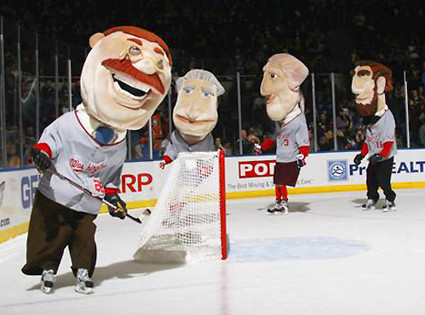
The Washington National baseball club President mascots, Teddy Roosevelt,
Thomas Jefferson, George Washington and Abraham Lincoln take to the ice

The Washington National baseball club President mascots, Teddy Roosevelt,
Thomas Jefferson, George Washington and Abraham Lincoln take to the ice
George Washington in his 2010 USA Olympic jersey
The annual tradition of the NHL Stanley Cup champion visiting the White House began in 1991 when Mario Lemieux and the Pittsburgh Penguins met with George H. W. Bush, which even merited its own hockey card from Upper Deck.
Here is a fun article about the Stanley Cup's most memorable White House moments.
In today's video section, President Obama welcomes the Pittsburgh Penguins, the eighth and final team he hosted at the White House, which included several humorous moments and plenty of impressive hockey insights.
Here is a fun article about the Stanley Cup's most memorable White House moments.
In today's video section, President Obama welcomes the Pittsburgh Penguins, the eighth and final team he hosted at the White House, which included several humorous moments and plenty of impressive hockey insights.
Sunday, January 14, 2018
1972 Soviet Union National Team Valeri Kharlamov Jersey
Considered to be one of the greatest players the game has ever seen, Valeri Kharlamov of the Soviet Union was born on this date in 1948. He joined the Central Red Army club in the Soviet Elite League in 1967-68 and scored two goals in 15 games as a rookie.
Soviet hockey legend Valeri Kharlamov
Having got his feet wet the season before, Kharlamov made no secret of his prodigious talent the following season when he increased his goal scoring to 37 goals in 42 games of the shorter Soviet League season. Following the season he would make the first of his 11 consecutive World Championship appearances and contributed 13 points in ten games on his way to the first gold medal of his illustrious international career.
In the 1969-70 season Kharlamov averaged a goal per game while playing in 33 contests for Central Red Army in a season which concluded with the first of four consecutive Soviet League championships. He followed that with ten points in nine games on his way to another World Championship gold medal.
Kharlamov won the Soviet League goal scoring title in 1970-71 with a career highs with 40 goals and 52 points in 34 games. He earned his first World Championship All-Star selection when he tallied 17 points in ten games as he was awarded his third consecutive World Championship gold medal, the dominant Soviet Union's 9th in a row.
He one-upped himself by capturing the Soviet League points scoring title in 1971-72, albeit with a lower personal point total that the previous season, with 40 points and was named the Soviet League MVP for the first time. That was not the highlight of Kharlamov's season however, as he introduced himself to the world as he led the Soviet Union to the gold medal at the 1972 Olympic Games in Sapporo, Japan where his 15 points in just five games led all scorers by six points as the world got their first real glimpse of his superior skating and playmaking abilities. Later that spring he was again named to the World Championship All-Star team, but had to settle for the silver medal for the first time.
In case anyone missed his performance in the Olympics, Kharlamov became a true star of international hockey with his performance in the fabled 1972 Summit Series when the best that the Soviet Union had to offer took on an All-Star team of Canadian professionals for the first time ever. While many in Canada assumed that their professional players would easily win all eight games of the series, Kharlamov led the Soviets with two goals in their stunning Game 1 upset of Team Canada on home ice in Montreal. While Canada led by two six minutes in, the Soviets quickly turned the tide, evening the score before the period ended and began to pull away with Kharlamov's two goals in the second on their way to a 7-3 win.
First teamed together in 1968, the line of Boris Mikhailov, Vladimir Petrov and Valeri Kharlamov, dominated international hockey throughout the 1970's
After losing Game 2, Kharlamov contributed another goal in their 4-4 tie in Game 3. After the Soviets 5-3 win in Game 4 in Canada, the series shifted to Moscow in the Soviet Union. When the Soviets came from behind 4-1 to win Game 5, Bobby Clarke of Canada deliberately broke Kharlamov's ankle in Game 6 which enabled the Canadians to stage a comeback and eventually win the series in a dramatic Game 8.
A fourth Soviet League title came in 1972-73 as he scored 32 points in 27 games after recovering from his broken ankle. A return to World Championship gold was powered by an on-from Kharlamov as he racked up 23 points in ten games for the host Soviet Union.
The consecutive championship streak ended in the Soviet League in 1973-74 but the World Championship success continued with another gold in 1974.
Prior to the start of the next season, Kharlamov again participated for the Soviet Union in the 1974 Summit Series, where they took on a team of mainly Canadian professionals from the World Hockey Association, which the Soviets won with a 4-1-3 record. Kharlamov contributed seven points in the eight games.
The Soviet League title returned to Central Red Army in 1974-75 as Kharlamov had a great season with 39 points in 31 games and yet another World Championship gold on the heels of 16 points in 9 games.
Kharlamov on the attack
While his personal scoring level continued unchanged in 1975-76, Kharlamov had to unusually settle for silver in both the Soviet League and the World Championships. All was not lost however, as the Soviet Union dominated the 1976 Olympic Games in Innsbruck, Austria to win the second gold medal of Kharlamov's career. He would be one of four Soviet players to tie for the tournament scoring lead with ten points in five games, including his game winning goal in their final game against Czechoslovakia.
Of interest, it was during the Soviet League season that the Central Red Army club took a break from domestic competition and participated in the first Super Series of exhibition games in North America against teams from the NHL which included a win over the New York Rangers, the enthralling tie against Montreal on New Year's Eve, called by many the greatest game of hockey ever played, another win, this time over the Boston Bruins and the notorious game against the Philadelphia Flyers when Kharlamov was targeted with an elbow to the head from the blind side which caused the Soviet coach to pull his team off the ice when to penalty was called.
That spring he was seriously injured in a car accident, which put his hockey career in jeopardy and cost him a chance to compete in the 1976 Canada Cup.
While Kharlamov was limited to 21 games because of recovery time from his injuries, the 1976-77 saw Central Red Army begin an era of dominance unlike any ever seen before with the first of 13 consecutive titles but the national team would fall to third place and the bronze medal at the World Championships.
Kharlamov would have one of his best offensive seasons when he totaled 42 points in only 29 games during the 1977-78 domestic season and a new run of gold medals would begin at the 1978 World Championships, the first of five in a row for the Soviet Union.
He was in peak form in 1978-79, scoring 22 goals and 48 points in the Soviet League, his greatest number of points since 1971. He had another impressive tournament at the World Championships with 14 points in eight games as the Soviet Union won gold on home ice in Moscow. He also participated in the 1979 Challenge Cup for the Soviet Union in a three game series against a team of NHL All-Stars which took the place of the normal NHL All-Star Game that season, which the Soviets won two games to one with a decisive 6-0 victory on Game 3.
1979-80 was a memorable campaign for Kharlamov as he added 38 points in 42 games and another Soviet League title. In February of 1980, his chance at his third consecutive Olympic gold medal was derailed by the "Miracle on Ice" during which the Soviet Union was upset by the United States in an upset so great that the loss was ranked the #1 story of the century by the International Ice Hockey Federation (IIHF). The Soviet Union eventually was awarded the silver medal with a 7-1 record. Of note, there were no World Championships held in 1980 due to the Olympic games.
A final Soviet League title for Kharlamov came in 1980-81 when he scored 25 points in 30 games. During his Soviet League career, Kharlamov scored 293 goals and 214 assists for 504 points in 436 games.
Sadly, on August 17, 1981, Kharlamov was killed at the age of 33 due to injuries suffered in a car accident which also claimed the life of his wife Irina.
In 1998, Kharlamov was inducted into the IIHF Hall of Fame. 2005 saw him become only the second non-NHL player to be inducted into the Hockey Hall of Fame, joining fellow Soviet player and teammate, goaltender Vladislav Tretiak. In 2008 he was selected as just one of six players to be named to the IIHF Centennial All-Star Team, honoring the best players in the 100 year history of the IIHF.
The IIHF Centennial All-Star Team announcement honoring Kharlamov, Tretiak, Slava Fetisov, Borje Salming, Wayne Gretzky and Sergei Makarov.
Other tributes to Kharlamov include a division of the top Russian professional hockey league, the KHL, being named after him, the the award for the top Russian player in the NHL each season being named the Kharlamov Trophy and the championship team in the junior league in Russia for players aged 17-21, the Minor Hockey League, is awarded the Kharlamov Cup.
Additionally, Kharlamov's #17 has been retired by both the Central Red Army club and the Russia National Team.
Kharlamov looking to score against Sweden
In total, Kharlamov won 11 Soviet League titles, eight World Championship Gold medals and two Olympic gold medals as well as one Soviet League scoring title, seven Soviet League All-Star awards and two Soviet League MVP awards and is the all-time leading scorer in the Olympics for the Soviet Union with 35 points in 17 games.
Today's featured jersey is a 1972 Soviet Union National Team Valeri Kharlamov jersey as worn in the 1972 Summit Series between the Soviet Union and Team Canada in which Kharlamov suffered a broken ankle after a deliberate slash in an effort to neutralize him.
Soviet National Team jerseys were generally quite spartan in appearance, using simple red jerseys with generally minimal striping and one color white names and numbers.
There were occasional dashes of flair, such as 1956's chevron striping, their first use of red and white after debuting in blue and white(!) in 1954, 1987's dual triangle look and the diamond trim used on their jerseys in the late 70's and early 80's, such as those worn during the "Miracle on Ice". Just the addition of yellow trim in the late 1980's was a radical departure after 30 years of only red and white sweaters.
Bonus jersey: Today's bonus jersey is a 1976 Soviet Union National Team Valeri Kharlamov jersey. This simple jersey style severed the Soviets well for over a decade, having used it as far back as the 1964 Olympics, wearing it through the 1976 World Championships. By 1976 the numbers used on the back were quite bold and much more professionally executed than the thin, seemingly hand cut numbers in the quirky font used in the 1972 Summit Series.
Bonus jacket: Today's bonus jacket is a 1970's Soviet National Team Valeri Kharlamov jacket as worn during the 1970's. Unusually, Kharlamov's name appears above the CCCP, which seems odd considering the entire philosophy of the team above the individual of the Soviet hockey system. Still, the arched name over his number 17 and the CCCP makes for a striking look for this great piece of seldom seen team gear.
Today's video segment begins with this tribute to Kharlamov.
Bonus jacket: Today's bonus jacket is a 1970's Soviet National Team Valeri Kharlamov jacket as worn during the 1970's. Unusually, Kharlamov's name appears above the CCCP, which seems odd considering the entire philosophy of the team above the individual of the Soviet hockey system. Still, the arched name over his number 17 and the CCCP makes for a striking look for this great piece of seldom seen team gear.
Today's video segment begins with this tribute to Kharlamov.
This next video is about the dedication of a monument to Kharlamov in Moscow and includes several interviews with former teammates who speak about their recollections of playing with him.
Here is one more very well put together tribute video to Kharlamov, followed by his induction into the Hockey Hall of Fame in 2005.
Labels:
Kharlamov Valeri,
Soviet Red Army,
Soviet Union
Subscribe to:
Comments (Atom)


